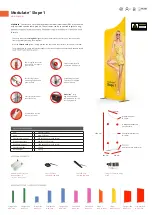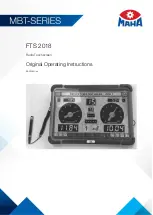
PAGE 9 OF 80
NIGHT SCAN CHIEF
OPERATING INSTRUCTIONS
TP-4602001-T
DECEMBER 2020
Fastener Vibration Hazard!
Mast system and payload mounting hardware must include proper
means to resist vibration loosening such as thread-locking compound, locking hardware, or
equivalent. Use specified assembly torques appropriate for the fastener size.
Frozen Water Hazard!
Water freezing inside mast may render mast inoperable and cause major
equipment damage such as tube deformation. Ensure water is free to exit at the base of mast.
Safety Instruction - Guy Anchors!
For masts using Guy Lines, verify the Guy Anchor point
strength is adequate to support the Guy Line forces.
Lubrication!
Do not lubricate the exterior of mast moving tubes. The lubricant will attract dust
and other environmental contaminants into mast.
Equipment Damage - Forces!
Before unloading the system, be certain the unloading region is
capable of resisting forces generated from unloading the system including but not limited to sys
-
tem weight. Ensure the unloading region is level and has sufficient room and strength to hold the
system. If the unloading region is incapable of meeting the requirements of the system, damage
to the system and/or unloading region could occur.
Equipment Damage - Support Bracket!
For masts using an upper support bracket, do not
over-tighten mast support bracket. Over-tightening may damage the Base Tube causing mast
tubes to stick.
Mast and Payload Access!
The operator must provide safe means to access mast and payload
during installation, removal and maintenance.
Tripping Hazard!
Cables, trip lines, guy lines and guy anchors can be hard to see during and
after installation. Any equipment posing trip hazards should be clearly marked.
Emergency Stow!
Using the emergency stow button causes the actuator to lower mast without
regard to any faults, switches, or system interlocks. It is totally up to the operator to ensure safe
operation during an emergency stow attempt. When using the emergency stow button, normal
operation switches are disabled. The mast can be overdriven into saddle and cause damage to
the unit. Disengage the emergency stow button when the payload reaches the saddle and is
tight. Do not drive mast beyond this position.
Manual Tilt!
If manually tilting mast, make sure all power has been disconnected from the sys
-
tem prior to manually lowering mast to avoid unexpected motion and/or damaging mast compo
-
nents.
Summary of Contents for Night Scan Chief 1.0
Page 2: ......
Page 6: ...PAGE 4 OF 80 NIGHT SCAN CHIEF OPERATING INSTRUCTIONS TP 4602001 T DECEMBER 2020 ...
Page 22: ...PAGE 20 OF 80 NIGHT SCAN CHIEF OPERATING INSTRUCTIONS TP 4602001 T DECEMBER 2020 ...
Page 55: ...PAGE 53 OF 80 NIGHT SCAN CHIEF OPERATING INSTRUCTIONS TP 4602001 T DECEMBER 2020 ...
Page 56: ...PAGE 54 OF 80 NIGHT SCAN CHIEF OPERATING INSTRUCTIONS TP 4602001 T DECEMBER 2020 ...
Page 57: ...PAGE 55 OF 80 NIGHT SCAN CHIEF OPERATING INSTRUCTIONS TP 4602001 T DECEMBER 2020 ...
Page 58: ...PAGE 56 OF 80 NIGHT SCAN CHIEF OPERATING INSTRUCTIONS TP 4602001 T DECEMBER 2020 ...
Page 59: ...PAGE 57 OF 80 NIGHT SCAN CHIEF OPERATING INSTRUCTIONS TP 4602001 T DECEMBER 2020 ...
Page 60: ...PAGE 58 OF 80 NIGHT SCAN CHIEF OPERATING INSTRUCTIONS TP 4602001 T DECEMBER 2020 ...
Page 62: ...PAGE 60 OF 80 NIGHT SCAN CHIEF OPERATING INSTRUCTIONS TP 4602001 T DECEMBER 2020 ...
Page 63: ...PAGE 61 OF 80 NIGHT SCAN CHIEF OPERATING INSTRUCTIONS TP 4602001 T DECEMBER 2020 ...
Page 64: ...PAGE 62 OF 80 NIGHT SCAN CHIEF OPERATING INSTRUCTIONS TP 4602001 T DECEMBER 2020 ...
Page 76: ...PAGE 74 OF 80 NIGHT SCAN CHIEF OPERATING INSTRUCTIONS TP 4602001 T DECEMBER 2020 ...
Page 81: ...PAGE 79 OF 80 NIGHT SCAN CHIEF OPERATING INSTRUCTIONS TP 4602001 T DECEMBER 2020 ...
Page 82: ...PAGE 80 OF 80 NIGHT SCAN CHIEF OPERATING INSTRUCTIONS TP 4602001 T DECEMBER 2020 ...












































